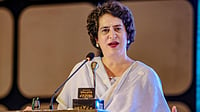Suchitra Sen is incomparable in the context of Bengali cinema and, to an extent, the larger Indian cinema. She commanded a respect in her lifetime which few actresses of the era could dream of, got characters written for her, had the box-office at her feet. Yet she could leave all of these and go on an exile in 1978 after Pronay Pasha and didn’t appear in public ever after (apart from probably two occasions) till her death two years ago. This reclusiveness equated her with Greta Garbo—the iconic American star of the 1920-30s.
It is quite a wait for the English reader for a book on the legendary actress. There was a coffee-tabler before this by the same author and one on Uttam Kumar and Suchitra Sen by Maitreyee B. Chowdhury. There are quite a few in Bengali, most of them trivialising her self-imposed reclusion and hinting at gossip. The book by Chatterji, hence, is a relief since it shuns petty sensationalism. Chatterji also disagrees in the first place that Sen can be compared with Garbo “because their reasons were different, they belonged to different cultures and different cinemas, and their life stories charted different territories”.
In the 1950s, Uttam Kumar and Suchitra Sen acted in over 20 films, almost all of them runaway hits. They had a chemistry yet unparalleled in Bengali cinema. Chatterji gives insights to their popularity on screen and the dignity they maintained in their relationship when gossip-mongers preyed on them. The book starts off with details about the magic of Uttam and Suchitra Sen—the reasons why they remained ahead of any other contemporary duo. Chatterji picks up a few films like Agnipariksha, Harano Sur, Rajlakshmi o Sreekanto, Saptapadi and Nabarag to explain where Sen made her characterisations appear different as the duo represented different modes of melodrama. “Suchitra Sen, like Nargis and Madhubala, was, for a major part of her career, an unwitting victim of her beauty, her grace and her essential femininity that played down her potential capabilities as an actress,” writes Chatterji. The book goes into details to set out Sen against her contemporaries and those who preceded her, like Kanan Devi. One glaring miss is that there is no reference to Supriya Devi, who was a bit younger to Sen but acted probably in more films with Uttam Kumar than any other heroine and who also happened to be the live-in partner of the mahanayak.
After Saptapadi (1961), the duo decided to do less films together and travelled different trajectories to scale heights in their acting career. For Suchitra, Smritituku Thaak, Saat Paake Bandha and Datta are the notable ones without Uttam Kumar. However the chapter that demands special attention is the one titled ‘Working Women, Bengali Cinema and Suchitra Sen’. Without being pedagogic or theoretical, Chatterji charts out the roles that Sen played as a strong working woman, in films like Sabar Uparey, Indrani, Deep Jele Jai, Hospital, Uttar Phalguni (and its Hindi remake Mamta) and Aandhi. She says it was not accidental that Sen was offered roles with a heart and a strength of character that befitted her glowing external beauty.
The book is free-flowing, is not an eulogy of Sen and refrains from elaborating on the many controversies in which she was involved. There are not many books on any of the biggest stars of Indian screen which are analytical and yet offer a happy reading experience. Chatterji has successfully done this—her probing at the star’s image, her characterisations and her reel persona are an insight to a remarkable artist.


























